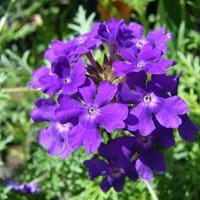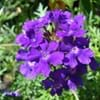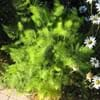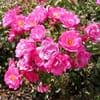Type
Flowering Plants
Vegetable
Origin
America, Europe
Central America, South America
Types
Clump verbena, Moss verbena, Annual Verbena, Brazilian verbena, Sandpaper Verbana
Bush Beans, Pole Beans
Habitat
Forest edges, Hillside, Woods
Cultivated Beds
USDA Hardiness Zone
3-9
Not Available
AHS Heat Zone
Not Available
Not Available
Sunset Zone
not available
A1, A2, A3, H1, H2, 1a, 1b, 2a, 2b, 3a, 3b, 4, 5, 6, 7, 8, 9, 10, 11, 12, 13, 14, 15, 16, 17, 18, 19, 20, 21, 22, 23, 24
Habit
Not Available
Vining/Climbing
Flower Color
Blue, Dark Purple, Light Purple, Red, White
Lavender
Flower Color Modifier
Not Available
Bicolor
Fruit Color
Not Available
Purple
Leaf Color in Spring
Dark Green
Green, Purple
Leaf Color in Summer
Dark Green, Green
Green
Leaf Color in Fall
Dark Green, Green
Green
Leaf Color in Winter
Not Available
Not Available
Plant Season
Early Spring, Late Autumn
Spring, Summer, Fall
Sunlight
Full Sun, Partial shade
Full Sun
Type of Soil
Well drained
Loam, Sand
The pH of Soil
Neutral, Slightly Acidic
Neutral, Alkaline
Soil Drainage
Average
Well drained
Bloom Time
Early Fall, Early Summer, Fall, Late Spring, Late Summer, Summer
Indeterminate
Tolerances
Not Available
Drought
Where to Plant?
Container, Ground
Container, Ground, Pot
How to Plant?
Seedlings, Stem Planting
Seedlings
Plant Maintenance
Medium
Medium
Watering Requirements
Do not water frequently, Medium, Never Over-water, Requires regular watering, Requires watering in the growing season
Do Not over Water, Requires regular watering, Water evenly
In Summer
Lots of watering
Lots of watering
In Spring
Moderate
Moderate
In Winter
Average Water
Average Water
Soil pH
Neutral, Slightly Acidic
Neutral, Alkaline
Soil Type
Well drained
Loam, Sand
Soil Drainage Capacity
Average
Well drained
Sun Exposure
Full Sun, Partial shade
Full Sun
Pruning
Prune for shortening long shoots, Prune if you want to improve plant shape, Prune lower leaves, Prune regularly, Prune to control growth
Remove damaged leaves, Remove dead branches, Remove dead leaves
Fertilizers
All-Purpose Liquid Fertilizer
5-10-10 fertilizer
Pests and Diseases
Not Available
Alternaria Leaf Spot, Anthracnose, Aphids, Armyworm, Bacterial Blight
Plant Tolerance
Drought
Drought
Flower Petal Number
Single
Single
Showy Foliage
Not Available
No
Foliage Texture
Not Available
Coarse
Foliage Sheen
Not Available
Matte
Invasive
Not Available
No
Attracts
Butterflies
Not Available
Allergy
Arthritis, Asthma, Chest Pain, Itchiness, Whooping Cough
Not Available
Aesthetic Uses
Showy Purposes
Not Available
Beauty Benefits
Not Available
Beautiful Skin
Environmental Uses
Air purification
Fixes Nitrogen
Medicinal Uses
Arthritis, Gallbladder Diseases, Itching, Jaundice, Joint pain, Kidney problems, Liver problems, Metabolic disorders, Sore throat, Upset stomach, Urinary tract problems
Cancer, Diuretic, Homeopathy, Hypotensive, Miscellany
Part of Plant Used
Flowers, Root
Leaves, Seedpod, Seeds
Other Uses
Air freshner, Can be made into a herbal tea, Cosmetics, Decoration Purposes, Economic Purpose, Employed in herbal medicine, Oil is used for aromatherapy, Oil is used in perfume, soaps, creams, etc., Showy Purposes, Used As Food, Used as Ornamental plant, Used for flavoring in Liquors, dairy products, gelatins,puddings, meats, candies, etc., Used for fragrance
Used for making brown dye, Used in biomass, Used in in reviving woollen fabrics
Used As Indoor Plant
No
Yes
Used As Outdoor Plant
Yes
Yes
Garden Design
Bedding Plant, Bonsai, Container, Edible, Herb
Container, Edible, Herb, Vegetable, Vine
Botanical Name
Purpletop Vervain
PHASEOLUS vulgaris 'Purple King'
Common Name
Verbena
String bean, Field bean, French bean
In Hindi
verbena
String Bean
In German
Eisenkraut
Bohne
In French
verveine
Haricot vert
In Spanish
Verbena
String Bean
In Greek
λουίζα
Αμπελοφάσουλο
In Portuguese
verbena
Feijão de corda
In Polish
werbena
Fasolka szparagowa
In Latin
Grindelia
Gloria Bean
Phylum
Magnoliophyta
Magnoliophyta
Class
Magnoliopsida
Magnoliopsida
Family
Verbenaceae
Fabaceae
Clade
Not Available
Angiosperms, Eudicots, Rosids
Tribe
Not Available
Phaseoleae
Subfamily
Not Available
Faboideae
Number of Species
Not Available
Importance of Verbena and String Bean
Want to have the most appropriate plant for your garden? You might want to know the importance of Verbena and String Bean. Basically, these two plants vary in many aspects. Compare Verbena and String Bean as they differ in many characteristics such as their life, care, benefits, facts, etc. Every gardener must at least have the slightest clue about the plants he wants to plant in his garden. Compare their benefits, which differ in many ways like facts and uses. The medicinal use of Verbena is Arthritis, Gallbladder Diseases, Itching, Jaundice, Joint pain, Kidney problems, Liver problems, Metabolic disorders, Sore throat, Upset stomach and Urinary tract problems whereas of String Bean is Cancer, Diuretic, Homeopathy, Hypotensive and Miscellany. Verbena has beauty benefits as follows: Not Available while String Bean has beauty benefits as follows: Not Available.
Compare Facts of Verbena vs String Bean
How to choose the best garden plant for your garden depending upon its facts? Here garden plant comparison will help you to solve this query. Compare the facts of Verbena vs String Bean and know which one to choose. As garden plants have benefits and other uses, allergy is also a major drawback of plants for some people. Allergic reactions of Verbena are Arthritis, Asthma, Chest Pain, Itchiness and Whooping Cough whereas of String Bean have Not Available respectively. Having a fruit bearing plant in your garden can be a plus point of your garden. Verbena has no showy fruits and String Bean has showy fruits. Also Verbena is flowering and String Bean is not flowering . You can compare Verbena and String Bean facts and facts of other plants too.





